The caddies of Augusta National Golf Club
Published: Last updated:
The caddies of Augusta National are just as iconic as the club’s azaleas and Green Jackets, but their role in the Masters too often overshadowed.
Today’s Golfer’s 2023 Major coverage is brought to you in association with TaylorMade.
The story of Augusta National Golf Club and the Masters Tournament cannot be told without the famed caddie corps taking a lead role for the world’s most famous golf course. The bright white jump suit, topped by a green golf cap, that the caddies have traditionally worn is only the famous outfit that identifies the caddies. But the historic nature of the caddies’ impact runs much deeper.
THE MASTERS: The story of the Green Jacket… and how it was nearly peach!
In 1931, when Bobby Jones announced that he was going to build his dream golf course in Georgia, the ‘godfather’ of the Augusta National caddies was already making his mark. Willie ‘Pappy’ Stokes earned his nickname as a youngster because his slow movement resembled that of an elderly man.
Widely recognised in Augusta National caddie circles as the man who taught most of the ‘name’ caddies how to read the undulating greens, Pappy was born on the grounds of the golf course. His father worked at Fruitland nurseries, one of the world’s largest plant establishments that brought many of the flowering plants to Augusta and closed years before the club being founded. The Stokes family lived in a home on the edge of the property, probably somewhere in the vicinity of Washington Road, which was, in those days, a dirt road. Pappy was born in 1922.

When construction of the course began, 10-year-old Pappy was the water boy for workers clearing trees and planning its routing. This is where he learned in great detail the lay of the land for his future profession. He watched the water from rainstorms drain toward the lowest part of the property where Rae’s Creek flows.
THE MASTERS: The Champions Dinner: History, menus and what Tiger will serve
“I was born and raised there,”he remembered, prior to his death in 2006. “It was a farm when I was young. I went out there every morning and I’d plow for cotton and corn. When they started building the course, I remember cutting down trees on No. 10 and No. 11. Washington Road used to almost come right through my yard.”
When Augusta National opened in January 1933, Pappy jumped into the mix as a caddie. He soon became a go-to caddie, earning five victories – in 1938 with Henry Picard, 1948 with Claude Harmon, 1951 and 1953 with Ben Hogan and 1956 with Jack Burke Jnr. Only Willie Peterson, who was on Jack Nicklaus’ bag for his first five Masters wins, has as many caddie victories (jump to the most successful Masters caddies).

Pappy’s greatest shared wisdom to younger caddies was that all putts break toward Rae’s Creek, the lowest point on the Augusta National property. For decades, the Augusta caddies kept that a secret. Today, there are framed individual hole diagrams hanging on the walls of the Augusta National caddie facility, located beside the practice area, each with a distinct red dot placed on a portion of the green, showing the direction of Rae’s Creek. Just about every visiting caddie has studied those drawings to gain more local knowledge.
The group that Pappy tutored, mostly on Saturday mornings, was largely made up of young black males from surrounding neighbourhoods. Many learned the trade as an income source to support their families as pre-teenagers at Augusta Country Club, which borders Augusta National’s Amen Corner, and ‘graduated’ to Augusta National as the club became more prominent in the 1950s.
THE MASTERS: Bobby Jones – The untold stories of Augusta National’s co-founder
The success of an all-black group was a point of pride in Augusta’s predominately black inner-city neighbourhoods as the American Civil Rights movement gained momentum, and it was a sore point when outside caddies who were players’ regular PGA Tour caddies, most of them white, were allowed to carry in the tournament from 1983 on.
In 1996, Caddiemaster Inc, a company now owned by Troon Golf, the world’s largest club management company, took over Augusta National’s caddie programme and, in essence, turned a unique and historic caddie yard into a more corporate system.

“We were the best caddies in the world, and we took pride in getting better,” said Jariah Beard, who was on Fuzzy Zoeller’s winning bag in 1979, leading the last rookie to a green jacket. “We challenged each other about who could read the greens best, who could pull clubs the best,” he smiled.
THE MASTERS: How a scorecard mistake cost de Vicenzo Augusta glory
A trio of caddies quickly moved to the forefront under Pappy. Nathaniel ‘Iron Man’ Avery was assigned to work for Arnold Palmer when Arnie first came to Augusta in 1955.
They teamed up for Masters titles in 1958, 1960, 1962 and 1964, with Iron Man among the first black caddies to earn interviews among the traditional press. He also motivated Palmer to a birdie-birdie finish in 1960 when he reacted to an angry club thrown by Palmer with: “Are we chokin’, Mr Palmer?”

Willie Peterson was a flamboyant presence on the course, dancing and motioning for the ball to go in the hole and wagering among his caddie brethren on Nicklaus’ scores – a directly opposite personality to the usually insular Nicklaus. They teamed up to phenomenal effect, claiming victories in 1963, 1965, 1966, 1972 and finally in 1975.
THE MASTERS: Eyewitness – Tiger’s first victory relived
And then there was Carl Jackson, who formed a close bond with Ben Crenshaw in 1976 and won titles with him in 1984 and 1995. In addition, he befriended and caddied for member Jack Stephens, the fourth Chairman of Augusta National, and today works as the caddie manager at The Alotian Club in Arkansas, a private course owned by Stephens’ son, Warren.
“Ben made me a part of his game, deep into his game,” said Jackson, who caddied in 53 Masters in total, beginning at age 14 in 1961. “I felt like I had won, too.”

The President’s Caddie
The Augusta National caddies’ expertise extended some way beyond their extensive knowledge of the course. They also had instincts similar to a psychiatrist, reading a player’s attitude and either picking up a downtrodden player during a round or settling a charging player so that he remained on an even keel.
THE MASTERS: 2008 champion Trevor Immelman on beating Tiger and his injury heartbreak
Even a sense of humour was effective. Examples include the antics of Peterson and those of Walter ‘Cricket’ Pritchett, who draped a towel over his head on the back nine in 1971 in an attempt to hide from the TV cameras – he had neglected to tell his boss at the bus company he worked for that he was caddieing at The Masters that week. The headwear amused his player enough to inspire him to the performance of his life – Charles Coody outdistanced the great Jack Nicklaus and Johnny Miller to capture the biggest win of his career.

Also note the myriad often magnificent nicknames given to Augusta National caddies. Gene Sarazen’s caddie when he made the albatross on the 15th hole in 1935 – the ‘shot heard around the world’ – was a man named ‘Stovepipe’, so named because he wore a tall stovepipe hat while caddieing and also in his daytime job as a preacher.
THE MASTERS: Inside Augusta National’s clubhouse
Or Willie Perteet, who became famous as US President Dwight D. Eisenhower’s personal caddie during the 1950s and 1960s. He was given the nickname ‘Cemetery’ by the 34th US President after Perteet survived a knife attack from a forlorn lover and woke up in the hospital morgue – to the shock of the attendant. ‘Iron Man’ earned his nickname either because he survived an accident with firecrackers or was injured in a knife fight with another man – the truth is unclear.
Carl Jackson represented a connection to the beginning, concluding six years ago when he spent time with Michael Greller, the caddie for Jordan Spieth who shared a Texas upbringing with Crenshaw. Jackson went through his weathered yardage book, schooling Greller on the intricacies of Augusta National. The result: a runner-up finish in 2014 and a record-tying victory in 2015 for Spieth.

Additionally, as the season’s normally first major championship is delayed until November because of Covid-19, the sage advice of those in the know will be vital. For years, Masters participants would leisurely visit Augusta National in the autumn to get their bearings.
As Augusta National is a winter club – closed from late May to mid-October – there is an expectation that players will rush in before this year’s tournament to get a feel for how the course plays versus April’s familiar conditions.
THE MASTERS: Sir Nick Faldo on his victories and Augusta learnings
Getting to know Augusta National’s caddies
More than 20 years ago, when I was the sports editor of The Augusta Chronicle newspaper, there were many stories of the Augusta National caddies.
However, there was little detail on the people behind the nicknames, much of it because the press didn’t pursue that storyline very often, probably because they were caddies and their all-black ranks weren’t considered appropriate for a mostly white reading audience. I was intrigued and spent five years researching and interviewing these famous caddies, resulting in the 2004 book Men on the Bag: The Caddies of Augusta National.
In 2019, a film project was completed which told the story of the caddie, evolving from Scotland and Ireland to the USA, and including the Augusta National caddie story as a centrepiece. It was called Loopers: The Caddie’s Long Walk and was narrated by the actor/comedian Bill Murray. The film showed in nearly 200 US and UK theatres, and is currently streaming worldwide and aired on Golf Channel and Sky Sports.
THE MASTERS: Ben Crenshaw on victories and Augusta’s changing face

To me, the most significant accomplishment of Loopers was memorialising one particular caddie – Nathaniel Avery, ‘Iron Man’. He died in 1985 as a broken man with severe alcohol issues, years after reaching a pinnacle as Palmer’s right-hand man. He was buried in downtown Augusta’s Southview Cemetery with no marker on his final resting place.
As the film was being completed in 2017, an anonymous donor paid for a granite headstone that denoted his nickname, his work with Palmer and the years of his Masters victories.
With Iron Man properly remembered, the long-standing impact of the Augusta National caddies should also be cherished.
Ward Clayton is the author of Men on the Bag: The Caddies of Augusta National (published by Sports Media Group) and a producer on the 2019 documentary, Loopers: The Caddie’s Long Walk
THE MASTERS: With anonymity guaranteed, the caddies reveal all about Augusta
The Masters Caddies Ranked By Wins
Five victories
Willie ‘Pappy’ Stokes
1938 (Henry Picard); 1948 (Claude Harmon); 1951, 1953 (Ben Hogan); 1956 (Jack Burke Jnr)
Willie Peterson
1963, 1965, 1966, 1972, 1975 (Jack Nicklaus)
Four victories
Nathaniel ‘Iron Man’ Avery
1958, 1960, 1962, 1964 (Arnold Palmer)
Steve Williams
2001, 2002, 2005 (Tiger Woods); 2013 (Adam Scott)
MORE FROM THE MASTERS
– How you can play Augusta
– Everything the champion wins
– With anonymity guaranteed, the caddies reveal all about Augusta
Want to get the most from Today’s Golfer? Sign up for TG Membership!
-
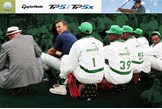 Augusta caddies wearing the famous white overalls.
Augusta caddies wearing the famous white overalls.
-
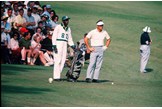 Arnold Palmer with Nathaniel 'Iron Man' Avery.
Arnold Palmer with Nathaniel 'Iron Man' Avery.
-
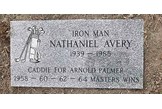 A plaque in tribute to Nathan 'Iron Man' Avery.
A plaque in tribute to Nathan 'Iron Man' Avery.
-
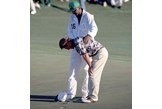 Ben Crenshaw breaks down with Carl Jackson after winning the 1995 Masters.
Ben Crenshaw breaks down with Carl Jackson after winning the 1995 Masters.
-
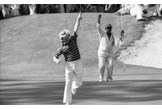 Jack Nicklaus and caddie Willie Peterson celebrate.
Jack Nicklaus and caddie Willie Peterson celebrate.
-
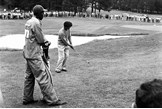 Willie 'Pappy' Stokes caddying for Ben Hogan.
Willie 'Pappy' Stokes caddying for Ben Hogan.
-
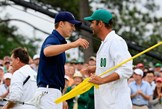 Jordan Spieth and Michael Greller.
Jordan Spieth and Michael Greller.
-
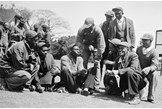 Sarazen’s caddie ‘Stovepipe’ shows other caddies the club which hit ‘the shot heard around the world’; an albatross on the 15th in 1935.
Sarazen’s caddie ‘Stovepipe’ shows other caddies the club which hit ‘the shot heard around the world’; an albatross on the 15th in 1935.
-
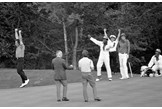 Jariah Beard jumps for joy as Fuzzy Zoeller wins the Masters in 1979.
Jariah Beard jumps for joy as Fuzzy Zoeller wins the Masters in 1979.
